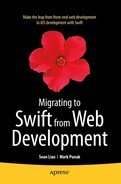Introduction
In 2000, I created my first mobile app for an inventory-tracking project using PalmOS handheld devices. The initial project was a full-staffed team effort that consisted of mobile developers, SAP consultants, supply-chain subject-matter experts, middleware developers, QA testers, architects, business sponsors, and so forth. JavaME came up strong in 2002, followed by Pocket PC/Windows Mobile. I did several mobile projects in which I converted mobile apps to the Pocket PC platform by blindly translating C++ to JavaME to C# .NETCF mobile code. These “translation” efforts prolonged the whole product life cycle. The project achieved a higher return on investment (ROI) by extending the product life because the extra cost of translating mobile code was surprisingly low. Ever since then, I have been translating front-end mobile apps among various mobile platforms. In recent years, most of my work has involved porting mobile apps between Android and iOS and mobilizing existing web sites. Porting apps between iOS and Android is fairly straightforward. This is also true for porting mobile web apps using a RESTful service. Even for traditional non-service-oriented web apps, you still want to follow the same path: reusing existing business cases and software artifacts and reaching a bigger audience to maximize the ROI.
One thing is for sure: there are a lot demands for mobilizing existing web apps to reach mobile users. That’s why I decided to write this book.
The primary objective of this book is to help experienced web developers leap into native iOS–Swift mobile development. It is easier than you think, and this book will make it even easier with step-by-step guidelines. You can immediately translate common mobile use cases to iOS.
Who Is This Book For?
This book was specifically written for web developers who want to make iOS mobile apps. The book will show you the common iOS programming subjects and frameworks by relating them to your familiar web programming tasks when appropriate.
How This Book Is Organized
In part I, you will get the iOS Xcode integrated development environment (IDE) up and running. You will be guided in creating tutorial projects that will become your porting sample projects. I believe this is the best way for you to get hands-on experience while learning programming topics.
Part II of this book shows you how to plan and structure your iOS apps by creating a storyboard and breaking the app into model-view-controller (MVC) classes. The common mobile topics are followed, including creating a user interface, managing data, and enabling networking with remote services. You will then be able to create simple but meaningful iOS apps with rich UI components and be able to handle common create, read, update, delete (CRUD) operations locally and remotely.
Last, Part III walks you through a case study for a complete iOS app. It recaps the topics in this book. You can also use the book’s table of contents or index to help find the mobile topics you need.
A bonus chapter was added in the end reveals how to mix and match web front development with iOS SDK, the so-called hybrid apps. You may choose to bundle the web contents and HTML pages with Javascript code just like you normally do for frontend web apps. You can interface with the native iOS platform features and communicate between your JavaScript and iOS code back and forth.
When you complete this journey, you will be able to use Xcode and Swift to effectively implement simple and meaningful iOS apps.
